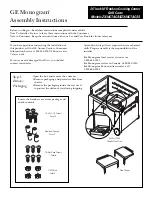
HEAT Instructional Book
Page | 16
Version 1.0
Gas Safety and Installation Warnings
•
All gas connections should be made by a Professional qualified technician and in accordance with local
codes and ordinances. The installation must conform with local codes or, in the absence of
local codes, with either the national Fuel Gas Code, ANSI Z223.1/NFPA 54, or CAN/CGA-B149.1,
Natural Gas Installation Code or CAN/CGA-B149.2, Propane Installation Code.
•
Always check the Rating Plate to make sure the gas supply you are hooking up to is the gas type
the appliance is manufactured for.
•
Check the rating label on the left hand outside of the unit.
•
Do not twist the gas supply hose.
•
Before each use, visually inspect the gas supply hose for cracks, cuts or excessive wear. Replace
the hose if necessary. Check for gas leaks.
•
Gas Specifications: Be sure that the gas supplied to the appliance conforms to the model you
purchased. A Natural Gas appliance requires natural gas to operate; an LP appliance requires liquid
propane gas to operate.
•
Never connect the appliance to an unregulated gas supply line. Appliances operated without a regulator are
unsafe and will not be serviced until installed properly and safely. Unsafe operation without a gas regulator
will void the warranty of the appliance.
•
Appliances operated with NG (natural gas) gas must be installed with the NG regulator supplied with the
unit and set to 4.0" water column pressure.
•
Appliances operated with LP (liquid propane) gas must be installed with an LP regulator set to 11" water
column pressure.
•
Please contact your dealer and use a licensed contractor or installer to convert your appliance to the
different gas type.
•
CHECK TO ENSURE THAT THE GAS SUPPLY HOSE DOES NOT COME IN CONTACT WITH ANY
HOT SURFACE, SHARP OR ROUGH EDGES OF THE GRILL OR OUTDOOR KITCHEN
CONSTRUCTION. DO NOT KINK THE GAS LINE WHEN INSTALLING.
RATING PLATE LOCATION
















































